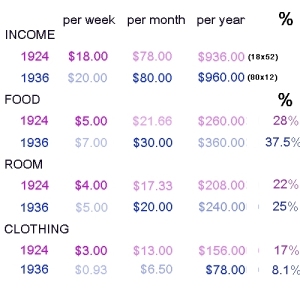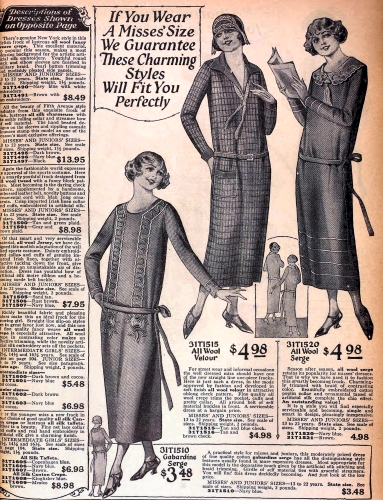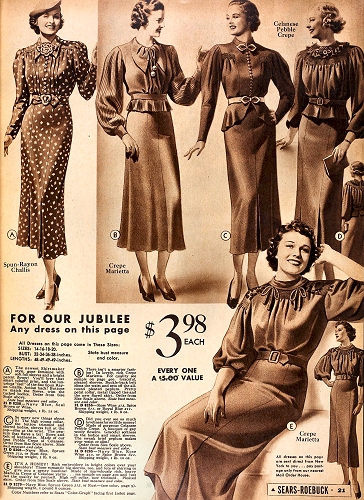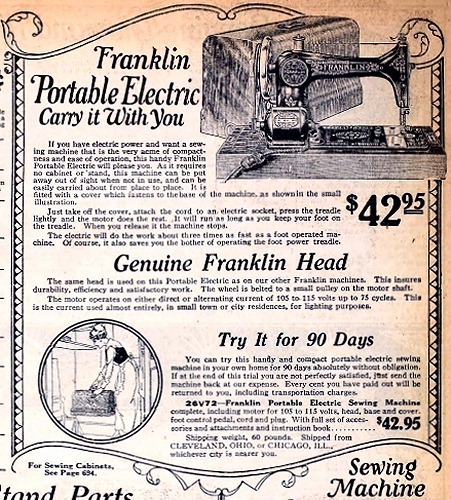It’s always hard to look at a vintage ad or catalog, see a pair of shoes for $6.50, and figure out whether they were expensive or affordable or really cheap at the time. A while ago, I found several articles about living on $18 per week in the 1930’s. Click here to read more about them. I’ll be citing some of the same charts here.
I’ve been looking through JoAnne Olian’s book on the B. Altman catalogs from the 1920’s. I was surprised by how high Altman’s clothing prices seemed, especially early in the decade. Then I remembered that I have some articles about clothing budgets in the 1920’s, which might give me a better idea of nineteen twenties’ clothing prices.
I decided to compare the nineteen twenties’ and thirties’ budget advice, and see if I could follow it by “shopping” at Sears.
I was struck by one similarity: In both 1924 and 1936, a college educated office worker — female — could expect to be paid “$18 per week.” So she probably wouldn’t be shopping from the B. Altman catalog; nevertheless, trying to look nicely dressed for work was a real concern.
This woman earned $18 per week in 1924:
“…It is necessary that I at all times look well. My wages are figured at the rate of forty cents an hour, which usually averages up to eighteen dollars a week.”
This woman earned $18 per week in 1937:
“… For several years I could not expect to earn more than $18 a week, even though … I was a bit above the average beginner. Therefore my small salary would just about pay my board and keep me in lunches and carfare with nothing left. I needed new clothes [for] the office … because my dress was so shabby.”
Woman’s Clothing Budget in the 1930’s
In 1936, this article asked “Can a college girl dress on a dollar and a half a week?”

“What Can A Girl Live On?” Woman’s Home Companion, Oct. 1936. Total clothing budget for the year: $76.55, about one month’s salary.
It concluded that . . .
. . . A college graduate making $20 a week in 1936 could afford to spend just $78 a year — $1.50 per week — on clothes. “By being economical she can live decently and comfortably on seven hundred and fifty dollars.” (In theory, she would also be able to save over $100 per year, and/or take a vacation! Or so they said.)
Woman’s Clothing Budget in the 1920’s
The stenographer who wrote to Delineator magazine in August, 1924, asked how a woman with an office job could live — and dress well enough to satisfy her employers — on $18 a week.
That’s right: The salary of a female office worker was exactly the same — $18 per week — in 1924 and 1936. But in 1924, The Delineator’s experts reached a somewhat different conclusion about her necessary expenditures on clothing.
In 1924, $3.00 per week was allowed for clothing purchases — twice as much as in 1936. But in 1924, she needed much less for food and lodging (50% of her income) than in the thirties (62.5%.)
Comparing a Working Girl’s Budget, 1924 and 1936
I’m not enthusiastic about the way Woman’s Home Companion rounded $18 per week up to “$80 per month or $960 per year,” so I’ve compared percentages of income as stated, and lightened my derived figures on this chart.) I multiplied $18 by 52 weeks; WHC multiplied $20 x 4 x 12 months.)

Percent of income spent on Food, Lodging, and Clothes as budgeted in Woman’s Home Companion (1936) and Delineator (1924). Click to enlarge. It assumes living in a rented room, probably without a kitchen, and eating many meals out.
Perhaps, during the Depression, food cost more, leaving less money for clothing? Or had mass produced fashions become much more affordable?
Just for fun, I tried to find comparable items in the Sears Roebuck catalogs for 1924 and 1936, always choosing the cheapest similar items I could find to build a stenographer’s wardrobe.
Comparing a Working Girl’s Clothing Prices, 1924 and 1936
After browsing through Sears Roebuck Catalogs for 1924 and 1936, I’m struck by the decrease in some clothes prices. (In both cases, I looked for the very cheapest, not the mid-priced, garments.)
Skirts and Blouses

Wool & wool blend skirts from Sears catalog, Fall, 1936. About $2.00 each. The cheapest costs $1.00.
Inexpensive blouses were easier to find in the thirties, too.

Inexpensive blouses from the Sears catalog, Fall, 1924. Three of these cost less than a dollar each, but the most expensive is $3.48 — or more, in stout sizes.

Blouses from Sears catalog, Fall 1936. Six cost $1 each, and the others are less than $2. Could any woman make her own blouse for $1 (pattern 15 cents, thread, material @ 14 to 69 cents per yard, and buttons)? Maybe.
A typist could buy a skirt and blouse for less than $3.00 in the thirties, or about $4.50 in the twenties. But she’d have to settle for the cheapest clothes available from stores like Sears, not from upscale department stores.
Dresses suitable for the office:
The cheapest Sears dresses (excluding cotton housedresses) cost about $5.00 in 1924:

Wool dresses suitable for for the office, Sears catalog, Fall 1924. These three were among the very cheapest in the catalog, with many more dresses in the $8 to $16 range. The average price of the 11 dresses described on this page is $7.39.
In 1936, most Sears business dresses were made of Celanese, rather than wool, so they are not strictly comparable.

Dresses from Sears catalog, Fall 1936. The $5 dress on the right can be transformed with different necklines.
The cheapest nineteen thirties’ office dresses from Sears are about $4; and the variety in this lowest price range is much bigger than in the twenties. Office workers with only one or two dresses could make it seem like they had more by wearing different collars. (See One Good Dress in the 1930’s. ) Patterns for “change-about” dresses were also available. In 1936, the Woman’s Home Companion budget allowed a stenographer just four dresses per year, at $5 each.
Coats
You could find a winter coat for about $9 at Sears in the twenties or the thirties. Of course, a coat was expected to last at least two years.

Inexpensive coats from Sears catalog, Fall 1924. Pure Wool cost more than ” wool velour” or duvetyn.
Better Sears coats cost two to four times as much as these. In 1924-25, a fur-trimmed wool coat from the B. Altman catalog cost $110 to $115:
Better quality fur-trimmed coats from Sears could cost $49 in 1924. And our “stenographer” had only $156 to spend on an entire, year-round wardrobe — coats, shoes, dresses, hats, stockings at about $1 per pair (a big ongoing expense), underwear, etc.
In 1936, The Woman’s Home Companion budgeted $12.50 for a winter coat, every other year. These coats from Sears are a real bargain — assuming that they actually kept you warm and dry.
Shoes:
Inexpensive shoes from Sears cost much less in the 1930’s than in the 1920’s:
In 1936, The Woman’s Home Companion allowed a young woman four pairs of shoes per year — at $3 per pair.
Conclusion: A careful shopper, fresh out of college and earning $18 per week, could definitely make her clothing budget go farther in 1936 than in 1924 — but she would not be buying $6.50 shoes, and no one with an eye for quality would consider her well-dressed.

Skirts and blouses from the B. Altman catalog, 1925. The ensemble on the left cost $18.50, a whole week’s salary; the one in the middle was $24.25, and the one on the right cost $24.50.
No wonder there was a boom in clothing patterns and home sewing in the 1920’s — largely because early twenties’ dress styles were easier to make than ever before. Isaac Singer is credited with the invention of the installment plan, but you’d have to make a lot of clothes to amortize the cost of a sewing machine….
Sewing Machine Prices, 1925 and 1936
In 1925, you could get a treadle sewing machine from Sears for $33, or a portable electric for $43. By 1936, you could get an electric portable or table model from Sears for less than $30 — but inexpensive machines with the new, round shuttle cost more — about $38. In either year, we’re talking about two weeks’ wages for a working woman.
CAUTION: I did this study for fun, and tried to be accurate. But these samples are much too small for real scholarship. Since not all issues of Delineator and Woman’s Home Companion are widely available — or indexed — I wanted to let serious students of economics know that this material exists — and deserves a more thorough evaluation than I am capable of doing.













Totally jealous of both budgets. I have a $0 clothing budget. 🙂
Fascinating! One thing struck me from the list of clothes per year though – are “step-ins” knickers/panties? Because 4 per year!!! Eww. Surely they would only do the laundry once a week and thus need 7 or 8? And the shoes must have worn out a lot to need 4 pairs a year without them being expected to last another year. I suppose they had to do a lot more walking than us.
Yes, knickers are undies — but they were usually hand washed. Standards of cleanliness were different (many men put on a clean collar, instead of a clean shirt, every day.) A woman on a budget could wash her stockings and undies in the bathroom sink. Delicate silks were not often trusted to a laundry. Shoes could be re-soled and re-heeled, but they do wear out fast when you only have four pair – probably one low-heeled for sports, one pair for evening, and one summer (light) and one winter (dark) pair for work. (I hope some lasted more than one year!) A doctor told me that the “healthiest” Americans are those who live in big cities — they walk to public transportation instead of driving everywhere. (Think of all those towns today that have no sidewalks, except for downtown.) “Hard on shoe leather,” as they ysed to say.
Ah, I suppose if she was washing them twice a week in her sink it makes sense, thanks 🙂 I didn’t think of that!
This is real scholarship, but based on a small sample. Your posts are always fascinating! I need to look into this further, but I’m pretty sure that government regulations in the 1930s helped to reduce clothing prices for some items.
Ah– I was forgetting about the response to the Depression. I have not found many issues of Delineator online, although today I did find that the Readers’ Guide to Periodical Literature (1900 to 1959) has been digitized and put online (Hooray!)by the Hathi Trust Digital Library: http://catalog.hathitrust.org/Record/000641605
My personal focus lately has been on what the “home ec” teachers were teaching students in the 30’s/Depression era, and budgeting on very little money was a major topic. Your comparisons are **very** interesting ~ thank you!
They add more understanding of how and why teaching sewing in schools was so wanted then. It’s no wonder to me that mail-away schools such as that of Mary Brooks Picken were so extensively patronized. Once a woman had learnt her sewing trade, she could earn more than a secretary, work at home, choose her own clients, and have a waiting list of women wanting her skills. Today, it’s the opposite…
Thank you for this very interesting article & references. Your research is much appreciated! xx
Thanks. I had never considered the importance of Government sponsored Home Ec classes until I read A Perfect Fit: Clothes, Character and the Promise of America by Jenna Weissman Joselit. If you haven’t read it, the bibliography might interest you.
Thank you for this! Will try to locate a copy! I learnt about the situation from The Lost Art of Dress by Dr. Linda Przybyszewski, and listening to her interviews (listed on her site). If you haven’t read it, you might give it a go… or listen to some of those interviews!
I didn’t know about the website. Thank you! Her lectures and a link to her blog are at http://www.professorpski.com/dress.html
Thank you for this. I wish more movie and tv costumers would tap into this and consider why a secretary should be shown wearing (admittedly ugly!) Celanese instead of wool crepe! My mom grew up in the 1930s, said they had very few outfits, but they made do, sometimes recutting old dresses into new styles. My grandma took an old baggy suit of Grandad’s in 1930 and turned it into a church suit — jacket and skirt– for herself. I still am in awe of that! When I started as an actor in the 1970s I had a $200/month job. Gas for the car was $5/week, rent and food cheap, and I had a $200 per year clothing budget. I made everything, including my winter coat, and bought shoes at the thrift. I am always so grateful I learned to sew, even tho I can’t get a paying job doing it now!
N
I am impressed by anybody who has made a coat! And, yes, it is sad that skilled stitchers can’t make a living from it anymore. There was a time when every town had at least one woman known for her sewing skills, and it was one of the ways to earn money at home, while juggling other responsibilities. Many women today have no idea how much a little bit of custom alteration can improve their look — and clothing no longer has any seam allowances, anyhow….
The coat was a splurge — I used a Vogue pattern, and it was worth every Penny. It took me thru each step, pad stitching, collar mysteries, lining and interfacing. Wow. A real tutorial. I’ve used that ever since. Friends take their stuff to a dry cleaner, but they could do it at home if they only knew how! I don’t do alterations for people I’m not living with! Lots of work and hard to charge for your time.
Fascinating analysis of budgeting in the Depression and before it.
One of the other factors worth considering is that by the 1930s, cars were much more common. The ability to people to drive to the city to shop shifted the types of goods being sold by mail-order. Generally, prices for mail order goods drop as automobiles become more available making going into town to shop easier.
Interesting idea. My family always commuted to The City by train, so the influence of the car on shopping habits would never have occurred to me.
So interesting! I’m currently reading a book about South Carolina textile mill workers from 1910 to 1948, and it has been eye-opening. The textile industry was booming in the late 1910s and into the 20s due to fabric shortages in WWI. This drove prices of fabrics and clothing up. To meet demand, production was increased, which over time, led to a glut of fabric. The bottom dropped out of prices in the late 20s, and then the problem was compounded by the Depression.
In 1933 the National Recovery Act set the minimum wage for textile workers at $12 a week.
Pingback: Clothing Budget for a Married Couple, 1925 | witness2fashion
I don’t think that step-ins were knickers – my mum wore them in the 50s and early 60s, and they were the Spanx of the day – elastic waist-thing that held you in, but didn’t have any fastenings (so you had to ‘step in’ to them). I think they also doubled as a garter belt, with stocking clips. Four would be reasonable as the elastic probably degraded over time, too.
This may be one of those British/American vocabulary differences — like “vest” and “undershirt”; in 1930 the American Sears catalog called underpants “bloomers”(they had elastic above the knee,) “panties.” and
“step-ins.” — also seen in 1924 catalogs. (In the U.S.,”knickers” came to mean outerwear that stopped below the knee, and “pants” are outerwear, too.) The step-ins that are underpants look like the bottom half of a “teddy” or “combination” from the 1920’s; girdles are listed separately on the budget. By the mid-1930’s lastex knitted girdles called “step-ins” were very popular, too, but cost more than 40 cents. I do personally remember those lastex tubes called “step-in” girdles from the 1950s. Thanks for giving me a reason to look this up — I can’t always trust my memory.
Thanks for the catalog page samples juxtaposed in one place! It’s just what I happened to be looking for.
Keep in mind thevintagetraveler’s very salient points, and other details of the economy in 1924 versus 1936. 1924 marked the spectacular rise of the stock market. October 24th, 1929 was the beginning of the Stock Market Crash; Black Tuesday was October 29th. 1932 and 1933 were the worst years of the Great Depression. The economy only began to nudge back up in 1934, and in 1936 the GNP rose a record 14.1%
So despite the beginning of a recovery, $3.48 in 1924 was only worth $2.81 in 1936. It may look as if you could buy clothes for significantly less, but once you calculate how much less the same money was worth, it changes the picture.
Add to that the effects of high textile production followed by a surfeit of those goods on its relative cost, and you start to get a sense of what was going on with those prices.
Thank you for the insight into relative dollar values. It’s not easy to find a good guide — or to choose among them. One theme that keeps appearing when I share sewing pattern articles from the 1930’s is the need to make one dress look as if you have three, by changing collars and other accessories. It’s difficult for most people born after 1970 or so to believe how few clothes ordinary people had — or could afford — in the past. We can’t conceive of wearing the same dress or suit to work, day after day. (I grew up in the 1950’s and 60’s, in old houses with tiny closets. I never had too many clothes to fit in them.) The need for wardrobe coordination was a frequent topic in women’s magazines from the thirties through the sixties: on a tight budget, anything I bought had to coordinate with clothes and shoes and the coat (one) I already had.
Such great research with the pictures – thank you so much
Pingback: Hosiery Ads with a Bit of Wit | witness2fashion
Pingback: Living on $18 per Week, 1930s | witness2fashion
Pingback: Vacation Needed | witness2fashion